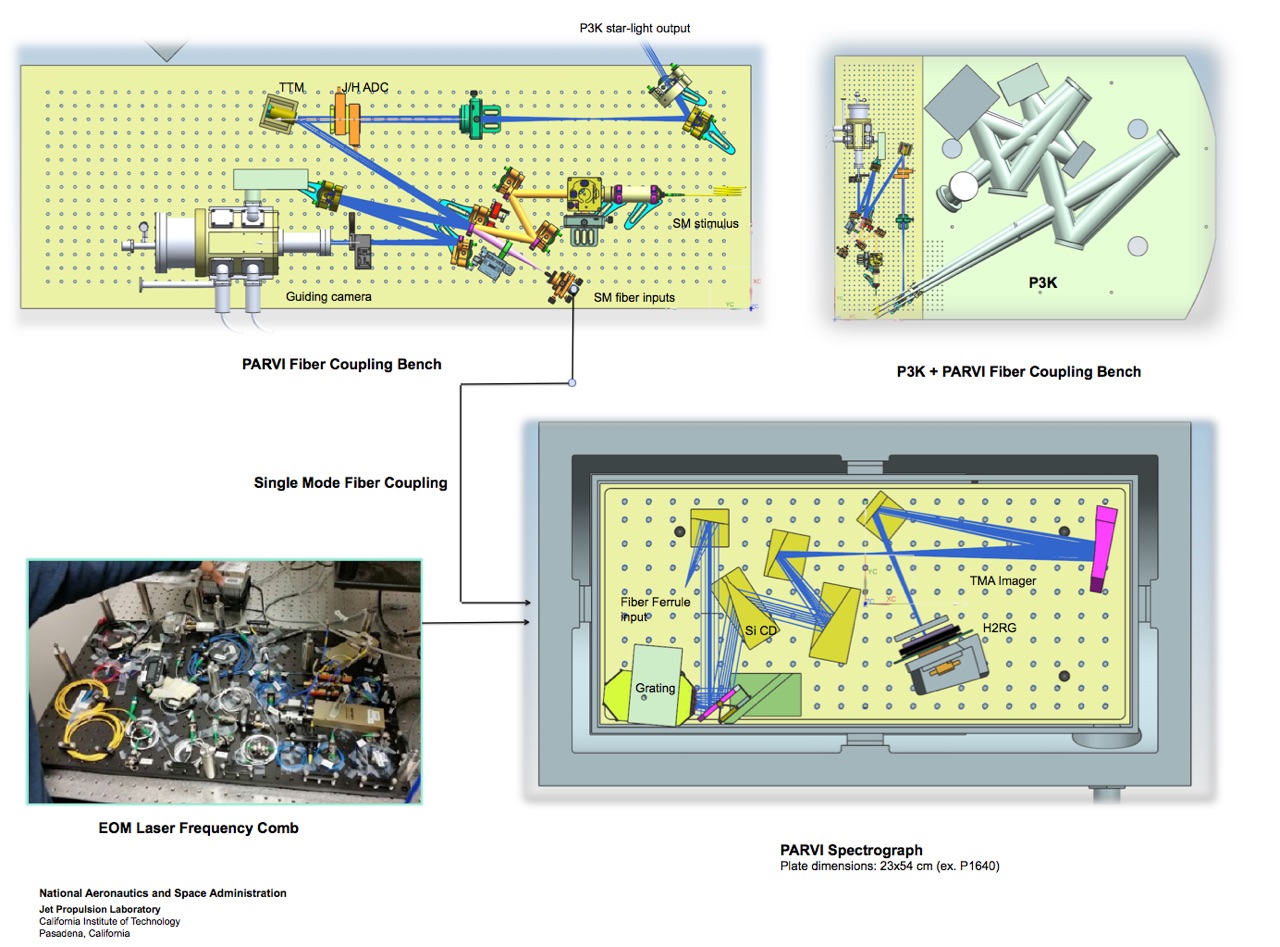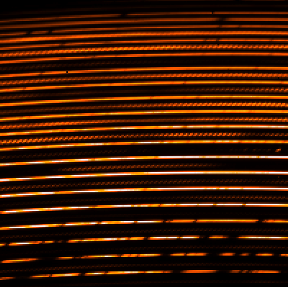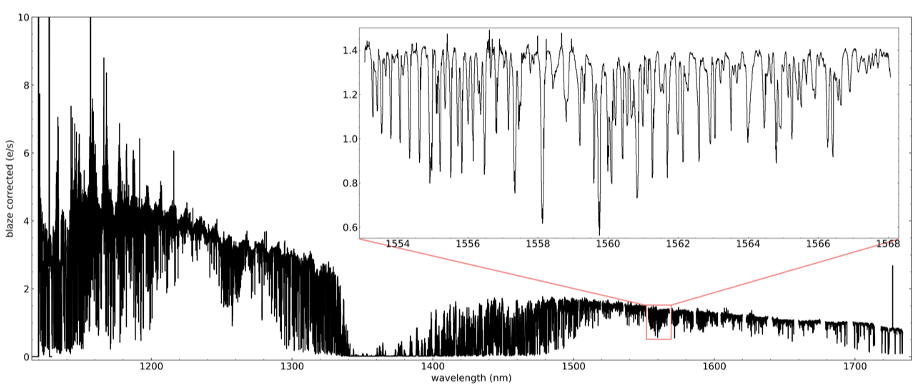Palomar Habitable Zone Planet Finder (PARVI)

Overview
The Palomar Radial Velocity Instrument (PARVI) is a near infrared fiber-fed diffraction limited high resolution spectrograph built for Doppler measurements of the host stars of extrasolar planets. PARVI uses a single-mode fiber-based design which feeds a R~100,000 cross-dispersed Echelle spectrograph, as well as a laser frequency comb (LFC) for stable and precise calibration. These features produce a compact, highly stable, high resolution spectrograph for extreme precision radial velocity (PRV) exoplanet studies as well as other astrophysics missions. PARVI has an ultimate goal of ~30 cm/s instrument radial velocity (RV) sensitivity, sufficient to characterize Earth mass planets orbiting in the habitable zones of low mass stars.
PARVI couples to the PALM-3000 (P3K) adaptive optics system at the Hale telescope at Palomar Observatory. It will conduct Doppler measurements of late type stars in search of low mass planetary companion, transit spectroscopy and Rossiter-McLaughlin measurements of known transiting exoplanets, and carry out follow-up activities for NASA's Transiting Exoplanet Survey Satellite (TESS) mission.
Hardware
PARVI has three primary components, the Fiber Injection Unit (FIU) which interfaces with P3K and couples the light from the Hale telescope into single-mode optical fibers, the Spectrograph which disperses and measures the spectra, and the Laser Frequency Comb (LFC) which provides a precise comb of laser lines to the spectrograph for wavelength calibration. The FIU uses a First Light CRED2 guide camera along with a back injected laser signal and a fast steering mirror to keep the light from the P3K ExAO system aligned and coupled with the output science fiber. The FIU output fiber chuck holds 4 single-mode fibers separated by ~100μm each which connect to a fiber run which goes from the Cassegrain cage of the Hale telescope telescope down through the building and into the spectrograph room on the ground level. One of these fibers is dedicated to carrying the science light down to the spectrograph and another is used to back-inject a laser to provide a precise reference location of the science fiber. The other two fibers are less frequently used, one provides a measurement of the sky background and the other allows the LFC light to be injected on the FIU and carried down to the spectrograph following the same path as the science light (alternatively the LFC can be injected directly into the spectrograph). The science and background fibers have a ~ 91 milli-arcsec field of view on the sky, and the guide camera has a 24.0 x 19.2 arcsec field of view on sky.The PARVI spectrograph reuses the cryostat and detector from the Project 1640 coronagraph . PARVI uses a R4 Echelle grating, a silicon prism cross-dispersing element, and a TMA camera design imaging onto a Teledyne H2RG detector. The spectrograph has a bandpass between 1145-1766 nm spread across 49 orders. It has a resolution (Δλ/λ) of 87,000-121,00 across the bandpass, and a RV per pixel of ~1 km/sec at 1559.9 (the LFC pump line wavelength). The diffraction limited nature allows for a compact design, which in turn allows for the high level of thermal stability required for the high precision long term measurements needed to reach our RV sensitivity goals. Active thermal control maintains the spectrograph temperature to a level of a few milli-Kelvin currently, and this stability will be improved when the new cryostat is integrated into the system.
The LFC is an electro-optic modulation based frequency comb with a spacing of ~0.08 nm between comb lines, and ~150-200 laser lines per order. The comb is fed by a pump laser locked to a HCN absorption feature at 1559.914 nm, which is used to generate a 10 nm wide 'seed' comb. This seed comb is amplitude stabilized, dispersion corrected, and then amplified to higher power. Once amplified it is spectrally broadened and then passed through a spectral flattener to minimize amplitude variation across the bandpass. The LFC is used during observations and combined with calibration measurements taken with a set of gas cells prior to observing runs to generate the wavelength solution for the spectrograph. The LFC is expected to reach ~10 cm/s RV stability.
Software
The PARVI data reduction pipeline (DRP) is based on the CERES libraries which provide general modules for processing Echelle spectra. The PARVI DRP has been modified to deal with the data from a near-IR H2RG detector as well as to read the Eschelle orders from a diffraction limited PSF rather than more traditional seeing limited instruments. The pipeline also needed to be adapted to generate a wavelength solution from the LFC data rather than just a lamp and gas cells. The DRP first generates a 2D echellogram from the H2RG raw data and calibration images, then uses the LFC spots to identify and trace the Echelle orders. The 1D spectra is then generated using the optimal extraction method. The wavelength calibration is produced using a combination of the LCF spectra, the HCN pump laser line, and a set of gas absorption cell measurements to identify the wavelength position of each LFC spot. Ultimately the PARVI DRP is intended as a fully automated pipeline, and we are investigating the use of both cross-correlation and forward modeling techniques for extracting the PRV signals from our data.
Status
PARVI was deployed to Palomar observatory in June of 2019, achieving first light spectra of the star Arcturus on June 14th, 2019. Despite the interruption of the Covid-19 pandemic numerous upgrades have been made to the system throughout its commissioning phase. We have upgraded our spectrograph components to improve PSF focusing on the detector, improved the temperature control of our LFC components to increase stability, and changed our FIU optics to reduce the platescale and improve our PSF on the guide camera. A new cryostat for the spectrograph had been designed and manufactured and is now undergoing acceptance testing. We returned to observations at Palomar in April 2021 and commissioning is ongoing.


Publications
Characterization of the C-RED 2: a high-frame rate near-infrared camera
Gibson, Rose K. ; Oppenheimer, Rebecca; Matthews, Christopher T. ; Vasisht, Gautam
Journal of Astronomical Telescopes, Instruments, and Systems, 6, 011002 (2020)
https://doi.org/10.1117/1.JATIS.6.1.011002
